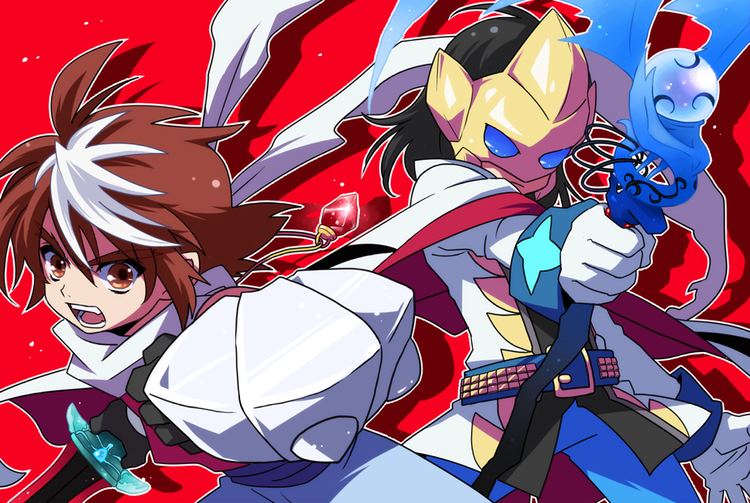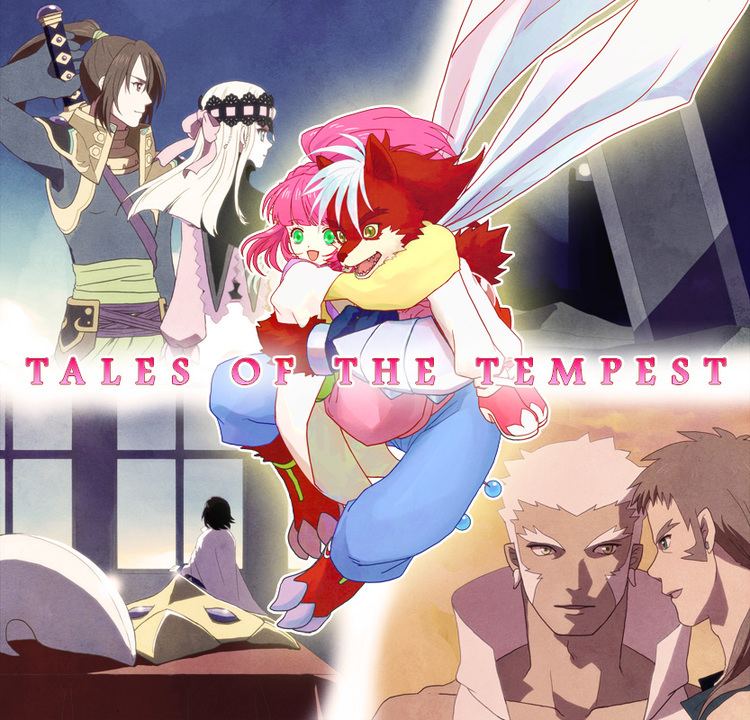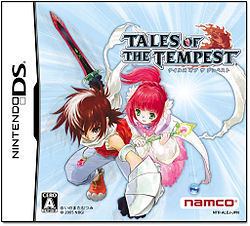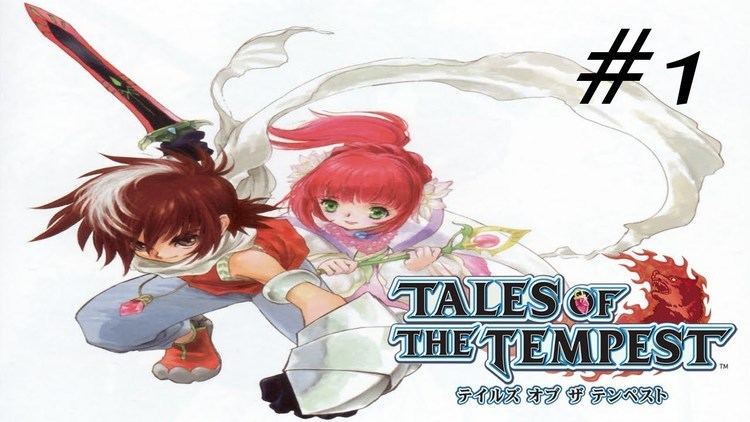8.8 /10 1 Votes8.8
Producer(s) Makoto Yoshizumi Initial release date 26 October 2006 | 4.4/5 Emuparadise Series Tales | |||||||||||||||||||||||||||||||||
 | ||||||||||||||||||||||||||||||||||
Director(s) Teruaki KonishiTakeshi Narita Writer(s) Shino TairaRiku OkimataMakio Kurita Mode(s) Single playerMultiplayer Publishers Bandai Namco Entertainment, Bandai Namco Holdings, Namco Similar Tales games, Mutsumi Inomata games, Role-playing video games | ||||||||||||||||||||||||||||||||||
Tales of the Tempest (Japanese: テイルズ オブ ザ テンペスト, Hepburn: Teiruzu Obu Za Tenpesuto) is an action role-playing game developed by Dimps and Namco Tales Studio, and published by Bandai Namco Games for the Nintendo DS exclusive in Japan. A spin-off "Escort" title of the Tales series, it was released on October 26, 2006. The game makes use of the Tales series' recurring Linear Motion Battle System, customized so characters and actions can be controlled and determined using the DS touch screen, as well as incorporating multiplayer elements.
Contents
- Tales of the tempest opening intro lyrics
- Gameplay
- Setting
- Characters
- Development and release
- Reception
- Legacy
- References

The game follows Caius Qualls, one of a race of wolf-life shape-shifters who are persecuted for previous disastrous abuse of their advanced technology. With his guardian and parents taken prisoner by the church authorities, he sets out on a quest with other outcasts to save them and overthrow the church's oppressive regime. The game's characteristic genre name is Tamashii o yobisamasu RPG (魂を呼び覚ますRPG?, RPG that Awakens the Soul).

Tempest was developed by Dimps, along with staff from Namco Tales Studio, including composer Motoi Sakuraba, designers Mutsumi Inomata and Daigo Okomura, and producer Makoto Yoshizumi. As the first title in the series to be developed for the DS, the concept behind it was to create a compact Tales experience for that platform. Yoshizumi moved to delay the game twice before its release so as to refine the experience. Upon release, the game polarized Japanese and western critics, with Famitsu Weekly giving it a notably harsh review. While some have praised the game's story and gameplay, others have faulted these and other aspects such as its technical quality and short length. Originally described by Japanese media as a main title, it was later classified and described by staff as a spin-off.

Tales of the tempest opening intro lyrics
Gameplay

Tales of the Tempest is an action role-playing video game. The player navigates the playable characters across 3D environments, including the overworld map, towns and dungeons.. The characters and environment are displayed on one screen of the Nintendo DS system, while menu options such as the character's current status are displayed on the other. The world is governed by a day-night cycle, effecting the environment and the behavior of elements within it. For instance, strong enemies appear at night, and towns cannot be accessed, but conversely some items and treasure are only available at night.
The battle system is a scaled-down version of the Tales series recurring Linear Motion Battle System (LMBS), a real-time system similar to a fighting game where character actions are performed at the press of a button, with specific buttons triggering either normal or special attacks. The version used in Tempest is called the "3-on-3 LMBS". The player controls one character, with the other three available in battle controlled by the game's artificial intelligence. After setting up a formation in advance, players can switch between characters at will during battle. During battles, characters can switch between three plains of movement, as opposed to previous 2D Tales titles which restricted characters to a single plain. This allows for characters to evade or surround enemies. Actions such as healing, character control and item usage are all controlled using the DS touch screen.
A stable gameplay element, Cooking, also appears. Cooking creates meals to restore health and Technical Points (used for special attacks). Once the right ingredients have been chosen and a recipe has been selected, the food can be made. Each ingredient is selected and added using the touchscreen. Using the wrong ingredients will make the cooking process go wrong. A meal cannot be used again until the party has rested at an inn or entered battle. Some meals carrying a special buff for characters when entering battles. The game's local multiplayer option is unlocked after a certain point in the single-player campaign after obtaining a special item. After that point, players can access a special multiplayer dungeon, where up to three players must work cooperatively to reach the treasure at the dungeon's center. If one of the players is defeated, the team restart at the nearest "resurrection point". Items and in-game currency are carried over into the single-player campaign, but experience points are not.
Setting
Tempest is set on the continent of Areura, where humans live alongside a half-beast race called the Reimon. The Reimon once dominated Areura, but they gained the ability to command a dangerous technology called Precepts, which was hoped would bring about coexistence between the races. Around the same time, hostile soul-eating spirits called Spots appeared, causing conflict. The experiment to bring about a unification of the races through the creation of the "Law of Life" entailed the forging of a gem called the Patient, which cost the lives of many Reimon. The Law of Life appeared in an imperfect form, killing most of the Reimon population and plunging the entire continent into chaos before the gateway was closed. In the aftermath, the formally-weak Humans rose up and took control. In later years, the human authorities would rewrite the history into an interracial conflict known as the Beast War, further soiling the Reimon's image. Tempest begins 100 years after the Beast War ends: humans are in dominance, and the Reimon are derogatorily called "Lycanths", and are shunned in human settlements or even hunted for rewards.
Characters
Development and release
The main concept behind Tales of the Tempest was to create a compact version of a standard Tales game. In addition, the team wanted to create a Tales experience that people could play on the go. Later, it was stated that the compression of features for Tempest and the staff's inexperience with the Nintendo DS caused multiple problems, including technical issues. The title, "Tempest", was derived from the concept of chaotic events and feelings. Makoto Yoshizumi, the producer for Tales of the Abyss, came over to produce the game once Abyss was completed. Tempest was the first Tales title to be developed for the Nintendo DS. It was developed by Japanese game studio Dimps. In contrast to previous Tales games, which featured a sizable amount of voice acting, Tempest restricted voice work to the execution of abilities and the completion of cooking.
The characters were designed by Mutsumi Inomata and Daigo Okomura. Tempest was Inomata's fifth time designing for the series. As part of her design, she created the characters with the DS graphics in mind. Okomura, a minor designer for the series, was responsible for designing the characters Albert and Rommy. In contrast to previous titles, which had purely animated openings, the game's opening cutscene used a mixture of CGI sequences created using the in-game graphics and animated segments by Production I.G.. The scenario was written by Shino Taira, Riku Okimata and Makio Kurita. Okimata was brought into the writing process halfway through production. The overall theme of coexistence between different nations and peoples was carried over directly from Abyss and Tales of Rebirth. Its characteristic genre name, a recurring feature in the series, was Tamashii o yobisamasu RPG (魂を呼び覚ますRPG?, RPG that Awakens the Soul). One of the main ambitions for the story was to make it comparable with one of the home console Tales games despite the platform and development goals. The game's music was composed by Motoi Sakuraba, the main composer for the Tales series. As his first work for the DS, Sakuraba found composing the music a challenge. One of the main problems was the limited sound capacity of the platform. As a result, it used a high degree of pop music. The title's theme song, "VS", was performed by misono, a singer who had previously performed the theme song for Tales of Symphonia while she was still a member of Japanese band Day After Tomorrow.
The game was originally announced as Tales DS in October 2005, with 2006 as its projected year of release. The game's official title was announced in December 2005. The game's release date was originally set for April 13, 2006. It was later announced that the game would be delayed. Its release date was moved to June 8 of the same year. It was then delayed again, with the release date being set as "before the end of 2006". The state reason for the delays was that the team needed extra time to properly develop the gameplay functions, which were specially designed for the DS. Yoshizumi later claimed personal responsibility for the delays.
Reception
In preparation for release, Bandai Namco prepared shipments totaling 301,000 copies. By November 2006, one month after its release, the game has sold 105,288 units. This was described by magazine Nintendo Dream as a fairly poor performance for a Tales game. As of 2008, the game has sold 205,541 units.
The game was reviewed twice by Famitsu: once in Famitsu Weekly and once in the dedicated magazine Famitsu DS + Wii. Famitsu Weekly gave it a score of 28/40, with the four reviewers each giving a score of 7. While it praised the battle system, which was stated to be more action-oriented than previous entries, multiple points came in for criticism, including poor companion AI, lack of content, and the limited online functionality. They also thought 2D graphics would have been better than the 3D models used due to quality issues. Famitsu DS + Wii gave the game a slightly higher score of 30/40, with the reviewers giving it respective scores of 8, 7, 7 and 8. The reviewers found the story "appealing", and enjoyed the increased focus on action in the battle system. Points of criticism were the map layout and leveling system. Dengeki DS Style praised the game's opening, but was mixed about the battle display and other aspects of gameplay. SoftBank Creative's magazine Gemaga also gave a mixed review, praising the opening song and battle system, but found that the condensing or removal of standard Tales gameplay elements made the game "unsatisfactory" when compared to its predecessors. Japanese magazine GAME SIDE, in a retrospective on the Tales series, cited the love story between Caius and Rubia as "pale", faulted the story's short length, and noted that the division of displays between screens during battle put undue pressure on the player.
Adam Riley, writing for Cubed3.com, was fairly positive, feeling that many of the Japanese reviews had been overly harsh. While he did find the battle system difficult to handle and the overworld too large, the story, graphics and soundtrack received praise. He also found the game good for short bursts of gameplay, enabling him to make the most of its 12-hour campaign. Kurt Kalata, writing for gaming site Siliconera, was generally negative. He called the game's low-budget look "[its] biggest problem", while also faulting the story, characters, lack of typical Tales features, and the design of the battle system. In his preview for IGN, Anoop Gantayat found the game fairly enjoyable despite impressions given by its delayed release, though he found issues with the touch screen controls.
Legacy
Several pieces of merchandise were created to either promote or supplement the game. As part of the promotion for the game, a 32-page booklet titled Tales of the Tempest Official Fan Book (テイルズ オブ ザ テンペスト オフィシャルファンブック), was created, including an interview with Inomata and trivia concerning the game and series. Three different guides to the game were published between October 2006 and February 2007. A two-part novel based on the game was published by Super Dash Bunko: the two volumes were titled Arashi no Shō (嵐の章?, lit. Chapter of Storm) and Kagayaki no Shō (輝きの章?, lit. Chapter of Sparkle). They were released in January and March 2007. The novels were written by Ryunosuke Kingetsu and illustrated by Inomata. They included extra stories and character development not included in the original game. The game's soundtrack album, Tales of the Tempest Original Soundtrack (テイルズ オブ ザ テンペスト オリジナル・サウンドトラック), was released on February 27, 2007. The album included an audio drama written by Okimata, portraying events between Caius and Rubia during the ending.
The game was originally described as a main entry in the Tales series. After the game's release, with the announcement of Tales of Innocence in July 2007, the series was divided between mainline "Mothership" titles and spin-off "Escort" titles. Tempest, described by Yoshizumi in 2007 as a precursor to Innocence, was officially reclassified as an Escort title at this point. It was speculated by Game Informer that the game's lack of critical and fan acclaim that caused the change, but this has not been confirmed. The game has yet to receive a western localization. Later, staff members of Innocence stated that Tempest was seen as a spin-off while still in development. After the release of the Vita port of Innocence, Innocence R, artwork found in that game caused speculation that Tempest might be remade. The "Triverse" connection between the three developed DS titles was established by Bandai Namdo producer Takashi Yota: first featuring in Innocence R, they were included in Tales of Hearts R after positive fan feedback. In 2014, it was revealed that Bandai Namco had been considering a remake of Tempest for some time, and that there was demand for both a remake by Japanese fans and a western release. So far, nothing has been announced.
